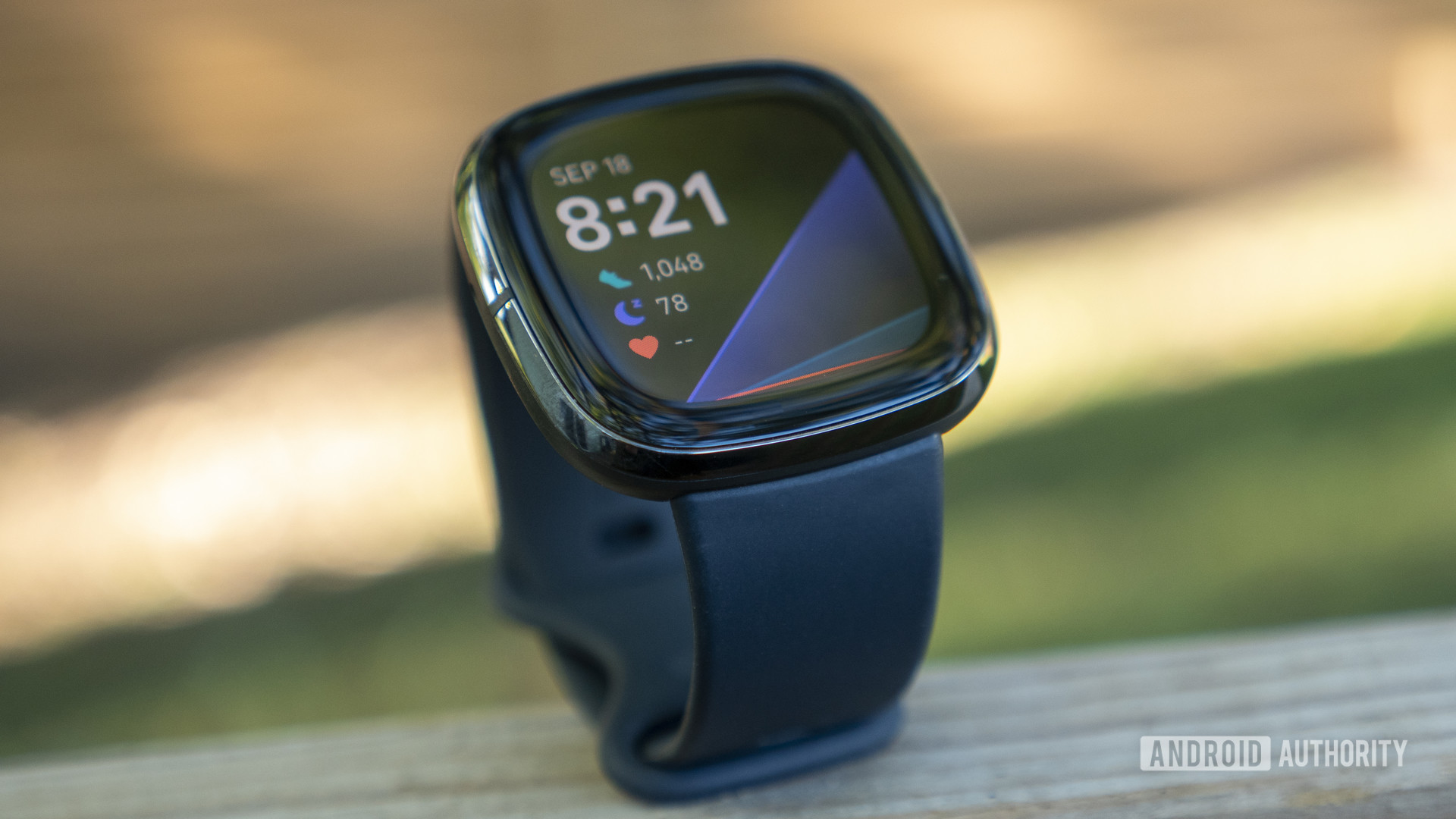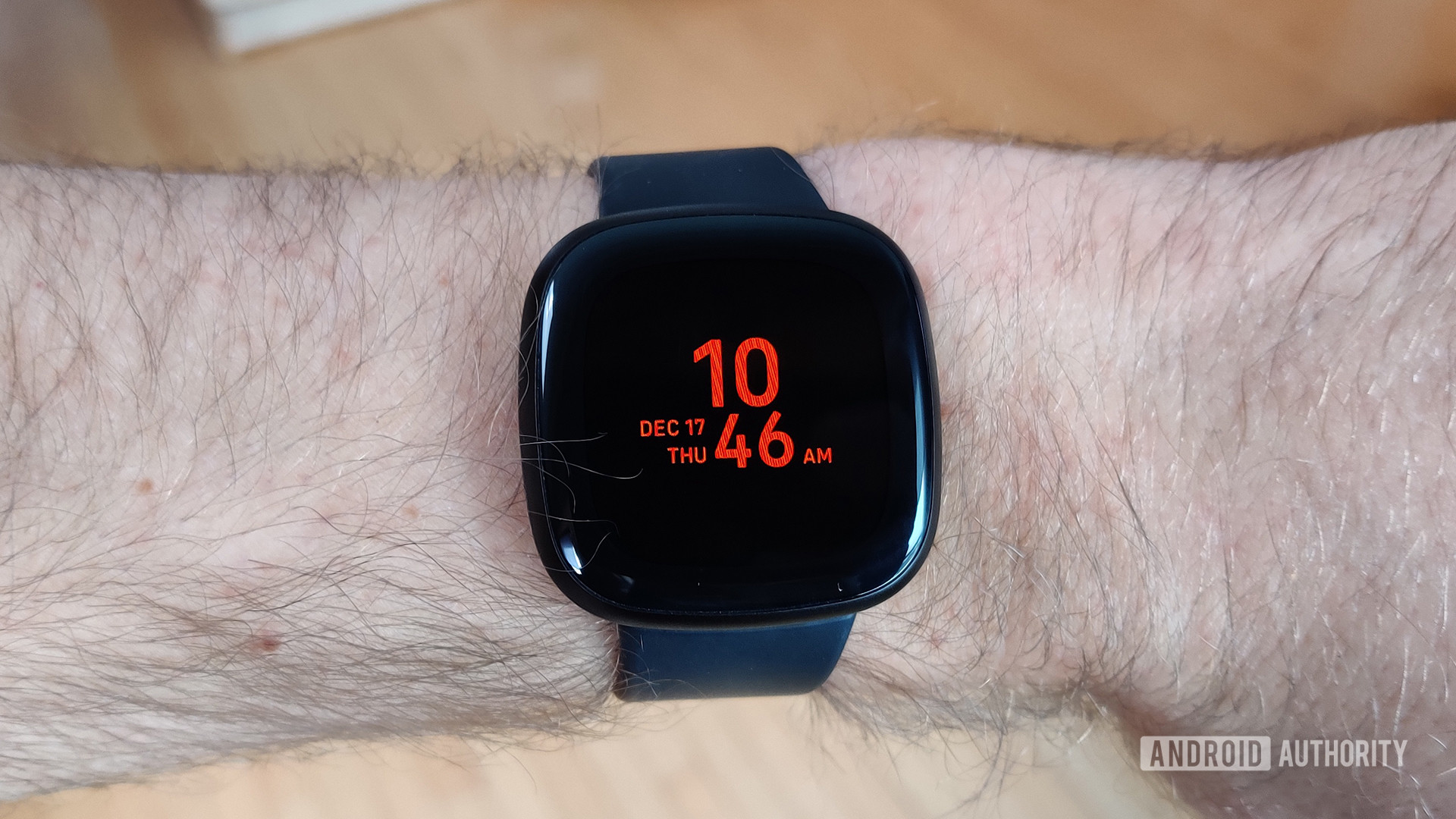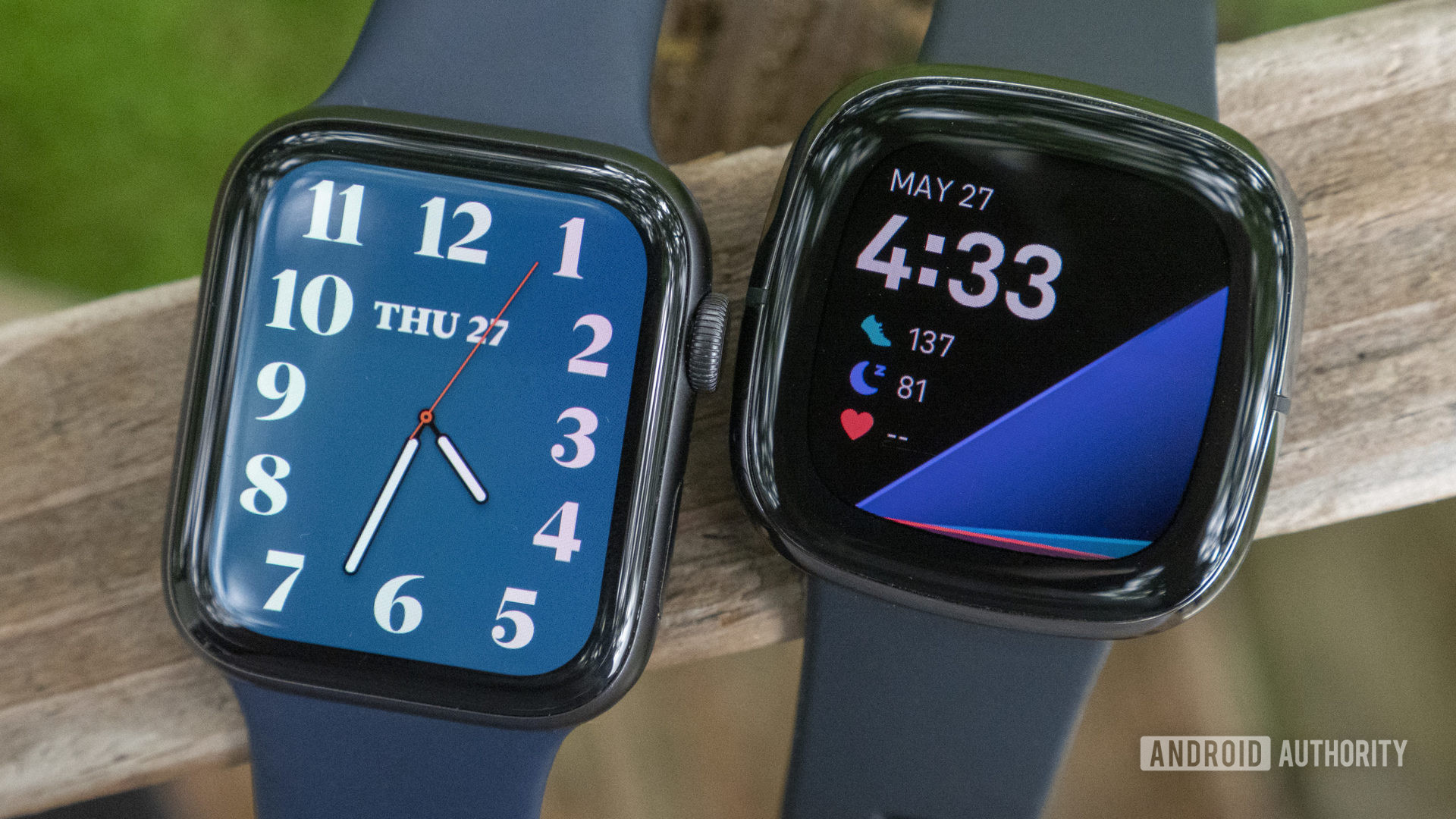Fitbit Sense buyer’s guide: Everything you need to know
Jimmy Westenberg / Android Authority
Table of contents
Fitbit jumped into the smartwatch game in 2018 with the first Versa. Given Fitbit’s forte, there was a lot of interest surrounding a device that was expected to offer the perfect balance between fitness tracking and smartwatch features, something you’d be hard-pressed to find even today.
The original Versa was far from perfect, but things have continued to get better with every successor. The Versa 2 was solid, and the most recent addition to the series — the Fitbit Versa 3 — is excellent. However, headlining the company’s smartwatch portfolio is the Fitbit Sense. It brings all the features you’d expect from a high-end smartwatch but is also the most expensive Fitbit yet. Here’s everything you need to know about Fitbit Sense.
Our verdict: Fitbit Sense review
Fitbit Sense at a glance

Fitbit Sense
Manage your stress and heart health
The Fitbit Sense is Fitbit’s flagship health-focused smartwatch. It has built-in ECG, GPS, and heart rate sensors, plus a new EDA Scan app that measures your body’s stress levels. This is by far Fitbit’s most advanced health watch so far.
The Fitbit Sense was launched alongside the Versa 3 in August 2020. It may not share the “Versa” moniker, but it’s definitely a part of the same lineup, only with more features. It’s essentially the Pro iteration of the Versa 3, but I’m glad Fitbit decided not to go that route while giving its high-end smartwatch a potential series of its own down the road.
However, it earns its health-focused bona fides by adding an EDA (electrodermal activity) sensor for stress tracking, a medically certified ECG (electrocardiogram) monitor, and a skin temperature sensor. It’s certainly not the first smartwatch to come with these features, but it’s great to see Fitbit keeping up with the competition in this regard.
See more: The best Fitbit trackers and smartwatches
Is the Fitbit Sense worth buying?

Jimmy Westenberg / Android Authority
The Fitbit Sense is certainly worth buying. But at close $300, it’s the most expensive Fitbit yet, so it depends on how much you’re willing to spend and whether the extra features are worth the surcharge.
The three additions — the EDA sensor, ECG monitor, and skin temperature sensor — aren’t up to scratch just yet and show the growing pains you’d see with any first-generation implementation. The EDA sensor’s stress tracking information is quite basic and not particularly accurate for now, at least compared to other watches that use heart rate variability for stress metrics. The ECG and skin temperature are useful but likely niche features for most users. The Fitbit Versa 3 is essentially the same device for $70 cheaper if you could do without the extras.
You can’t go wrong with the Fitbit Sense, but the Versa 3 might be the better option.
The other consideration is its premium smartwatch pricing itself. The Fitbit Sense is far from a glorified fitness tracker, but its smart features are still somewhat lacking compared to the competition. It gets the basic smartwatch features right. You can get smartphone notifications and respond to them if you have an Android device. You can use contactless payments via Fitbit Pay and download and store music on the watch (even though Spotify support is still missing). However, app selection remains limited, Fitbit OS is sometimes quite laggy, and it’s just not as capable as a smartwatch as others on the market.
The Fitbit Sense is ideal for:
- Anyone looking for an excellent fitness tracker
- Anyone who considers features like the ECG monitor, EDA sensor, and skin temperature sensors as “must-haves”
- Anyone already invested in the Fitbit ecosystem (Fitbit Premium in particular)
- Anyone looking for a worthy alternative to Garmin watches, the Apple Watch, or Samsung smartwatches
The Fitbit Sense may not be for you if:
- You’re looking for full-fledged smartwatch features
- You are looking for a budget-friendly watch
See also: The best smartwatches you can get in 2021
What reviewers are saying about the Fitbit Sense

Jimmy Westenberg / Android Authority
In his review, Android Authority’s Jimmy Westenberg says the Fitbit Sense is a good upgrade over the Versa 2. It definitely nails the basics and is an excellent fitness tracker. However, he adds that while “Fitbit’s hardware and fitness tracking efforts should not go unnoticed,” its software issues and limitations aren’t something we should see in a $300 smartwatch, particularly one that’s in its third generation.
He adds that Fitbit might not have done enough to justify Sense’s higher price tag over the similarly capable Versa 3. The extra features are useful, but the EDA sensor and available information “is not there yet.” He concludes by saying, “if Fitbit wants to compete in a world where the Apple Watch exists, it needs to be on its A-game. Right now, it feels like Fitbit is playing for the B-team.”
What other reviewers from around the web think
Here’s what other reviewers from around the web have to say about the Fitbit Sense.
- Cnet’s Lexy Savvides and Scott Stein have mixed feelings about the Fitbit Sense. They say that “if you want a health device to monitor your daily stats, and also wanted ECG on a Fitbit, this is your watch.” However, if you can do with the extra features, the Versa 3 is more than up to the task and is a great and cheaper alternative. “That way, you’ll save some dollars and wait for Fitbit to iron out the kinks for the next generation of Sense.”
- PCMag’s Angela Moscaritolo says the Fitbit Sense seems like a timely release given the ongoing pandemic. She adds that “while it’s first and foremost a health-tracking wearable, the Sense offers a few nice smartwatch features.” the ability to check your blood oxygen saturation level, heart rate, skin temperature, and stress level are useful features to have at this time. However, she says it’s the Sense’s high price point “that might give you pause,” considering the competition it’s up against.
- TechRadar’s Cat Ellis says that “the Fitbit Sense is one of the best Fitbits around right now, and builds on the success of the Fitbit Versa line with several thoughtful new upgrades.” She says it’s designed to put your well-being front and center and succeeds in helping make changes to improve your physical and mental health. However, she adds that the Fitbit Sense “isn’t perfect, though,” and the Fitbit companion app could use some work in particular.
Fitbit Sense specs
| Fitbit Sense and Fitbit Versa 3 | |
|---|---|
| Display | 1.58-inch touchscreen AMOLED 336 x 336 resolution 1,000 nits Corning Gorilla Glass 3 |
| Battery | Smartwatch mode: 6+ days Lithium-polymer battery Charge time: (10-80%): ~40 minutes |
| Memory | 4GB (2.5GB available for music storage) 7 days of motion data, daily totals for past 30 days HR data at 1-second intervals during exercise, 5-second intervals all other times |
| Materials | Sense: aluminum case, stainless steel ring for ECG Versa 3: aluminum case Classic strap: flexible material similar to that used in many sports watches |
| Sensors and components | Sense: Electrical sensors compatible with ECG & EDA app Sense: Skin temperature sensor Versa 3: Device temperature sensor Optical heart rate sensor Built-in GPS + GLONASS Gyroscope Altimeter 3-axis accelerometer Ambient light sensor Wi-Fi (802.11b/g/n 2.4GHz) NFC Vibration motor Speaker Microphone |
| Water resistance | 5ATM |
| Notifications | Call, text, calendar, email, music control, and much more |
| Compatibility | Android, iOS |
| Dimensions | Sense: 40.48 x 40.48 x 12.35mm 45.9-48.2g Versa 3: 40.48 x 40.48 x 12.35mm 41-43g Small strap: 140-180mm Large strap: 180-221mm |
| Colors | Sense: Carbon/Graphite stainless steel, Lunar White/Soft Gold stainless steel Versa 3: Black/Black aluminum, Pink Clay/Soft Gold aluminum, Midnight/Soft Gold aluminum |
Fitbit Sense hardware and design

Jimmy Westenberg / Android Authority
In his review, Jimmy calls the Fitbit Sense “a premium smartwatch through and through,” which starts with the design. It’s not a new look compared to its predecessors, but Fitbit uses premium materials for better build quality and further refines the existing formula to make a good-looking smartwatch.
The 1.58-inch AMOLED panel is impressive, gets plenty bright outdoors, and has good viewing angles. There’s a big bezel around the screen once again, but it’s almost a signature look at this point. It is significantly smaller than what we’ve seen on its predecessors, though. An inductive button on the side acts as a home button but isn’t placed very well and can be unresponsive at times. It’s a good idea in theory, but we’re hoping for better implementation with future generations.
The hardware is a huge step up over the Versa 2, but it could still use some work.
Another useful upgrade doesn’t have to do with the watch itself but its charger. The clasp-dock setup is thankfully gone, and the charger is now magnetic. You also get fast charging with the Fitbit Sense, allowing you to charge the watch from 10% to 80% in around 40 minutes.
How is the Fitbit Sense’s performance?

Jimmy Westenberg / Android Authority
Fitbit Sense
The Fitbit Sense is the company’s most health-focused wearable yet, with the addition of the ECG monitor, skin temperature sensor, and an EDA sensor for stress tracking. The issues with these new features don’t lie with the hardware itself but rather how they’re implemented. Scan results across the board are accurate for the most part.
However, the EDA scans didn’t offer much additional data regarding what the scans actually mean. Taking an ECG reading is a clunky process, but the results were pretty accurate. The skin temperature sensor doesn’t let you check your temperature throughout the day. Instead, it records the temperature of your skin at night, compares it to your personal baseline, and shows you trends over time. It’s useful the way it is to catch early signs of illness but isn’t the thermometer replacement some might have hoped for. Ultimately, these are all first-generation issues that will definitely improve with its successors.
The good news is the Fitbit Sense nails the usual health and fitness tracking features. Sleep tracking continues to be the best feature of any Fitbit, and the new heart sensor works extremely well unless really pushed. The Sense comes with built-in GPS, so you don’t have to carry your phone on a run, and the GPS recordings are the most accurate we’ve seen on a Fitbit so far
Also read: The best running watches you can buy from Garmin, Coros, and more
Fitbit is still relatively new to the smartwatch game, but there haven’t been any major upgrades over the years, and the app ecosystem is still lacking. There’s been some progress, but it is still falling behind in others compared to the competition the Sense is hoping to take on.
The watch comes with Amazon Alexa support and added the Google Assistant in June 2021. The implementation is a touch basic, so don’t expect the same responses and capabilities you’d get with a smart speaker. There’s no hot word response, though. Instead, you need to long-press the side button, say your voice command, and wait for the assistant to complete the task.
Music support still comes standard on the Fitbit Sense. You can download Pandora, Deezer, and local music files onto the Sense, but Spotify support is still missing. You get about 2.5GB of the total 4GB of storage for music, so you can add and store up to 500 songs on the watch.
App selection in the Fitbit App Gallery is where the Sense and all other Fitbit smartwatches fall behind the Apple Watch, Wear OS, and Samsung’s smartwatch app store. Navigating through the gallery remains slow and annoying, and Fitbit OS itself can be laggy at times. The Fitbit Sense gets most of the basic smartwatch stuff right, so you’ll get phone notifications and respond to them if you use an Android device. You can also use Fitbit Pay support for contactless payments, and it works really well.
Overall, the Fitbit Sense is an excellent health and fitness tracker with a few useful smartwatch features. Unfortunately, simply nailing the basics isn’t going to cut it in the price range the Sense wants to compete in, so there’s plenty of room for improvement.
Read more: The ultimate Fitbit buyer’s guide
Fitbit Sense vs Fitbit Versa 3: What’s different?

C. Scott Brown / Android Authority
The Fitbit Sense and the Versa 3 were launched together, and there actually aren’t many differences between the two as far as the basics are concerned. The design and build quality are practically identical, you get the same screen on both, and the smartwatch features are the same on both. The Versa 3 is available with a few different strap combinations, but you can always switch what you get with the Sense if there’s one you particularly like.
Don’t miss: Fitbit Versa 3 review
The Versa 3 covers all the essential health and fitness tracking features as well. It comes with an SpO2 sensor, built-in GPS, and even gets the new skin temperature sensor. The only extras you get with the Sense are the ECG monitor and the EDA sensor. Given the similarities in design and hardware, you can expect similar performance and battery life with both.
The features you need and your budget are ultimately going to be the deciding factor between the two. If the new form of stress tracking and ECG are must-haves, the Sense is a no-brainer. However, you can save between $70 and $100 with the Fitbit Versa 3, and you’re not really making a significant compromise regarding the overall experience.
For most people, we recommend buying the Fitbit Versa 3 over the Sense.
What are some good Fitbit Sense alternatives?

Jimmy Westenberg / Android Authority
The Fitbit Sense is pretty great, but it’s coming up against some pretty stiff competition in its price range, as we’ve alluded to. These are some of the Fitbit Sense alternatives worth considering:
- Apple Watch Series 6: This one’s a no-brainer if you have an iPhone. For iOS users, the Apple Watch is hard to beat. It trounces the Fitbit Sense with third-party app support and smartwatch features, and is beginning to rival the Fitbit in terms of fitness features. The Apple Watch also includes an ECG monitor, reliable GPS tracking, and excellent heart rate tracking.
- Mobvoi TicWatch Pro 3: The TicWatch Pro 3 is our pick for the best Wear OS watch you can buy, thanks to its long-lasting battery life and smooth performance. It’s not a great fitness tracker, though, so go for this if you’re looking for more of a smartwatch than a fitness tracker.
- Garmin Venu 2: If you want a smartwatch that can compete with the Sense for accurate fitness and health stats, the Garmin Venu 2 is a great option. It’s one of our favorite fitness watches of all time. Like the Sense, it’s more focused on fitness than smartwatch features, but it’s definitely a long list of fitness features.
- Samsung Galaxy Watch Active 2: The Galaxy Watch 2 offers a better balance between fitness tracking and smartwatch features. It’s not the best health tracker around, but better than most other “traditional” smartwatches. It’s also much cheaper than the Sense and the other watches on this list.
These smartwatches are on sale quite often. Be sure to check our best smartwatch deals hub for discounts on today’s popular wearables.
Where to buy the Fitbit Sense

Jimmy Westenberg / Android Authority

Fitbit Sense
Manage your stress and heart health
The Fitbit Sense is Fitbit’s flagship health-focused smartwatch. It has built-in ECG, GPS, and heart rate sensors, plus a new EDA Scan app that measures your body’s stress levels. This is by far Fitbit’s most advanced health watch so far.
The Fitbit Sense is available from Fitbit.com, Amazon, Best Buy, and other retailers for $329.95 in Carbon/Graphite and Lunar White/Soft Gold colorways. You’ll often see deals and discounts, though, so you could pick it up for as low as $279.95 with the right deal.
FAQs

Jimmy Westenberg / Android Authority
Q: Does the Fitbit Sense support contactless payments?
A: Yes, all versions of the Fitbit Sense come with Fitbit Pay support.
Q: Is the Fitbit Sense waterproof?
A: It comes with a 5ATM rating for water resistance, so you can use it for swim tracking.
Q: What watch straps can I use with the Fitbit Sense?
A: With its new latch, you are unfortunately limited to straps specifically for the Sense and the Versa 3. Luckily, there are quite a few first- and third-party straps to choose from on Fitbit.com and Amazon
Q: Is the Fitbit Sense compatible with my smartphone?
A: Most likely. The Fitbit companion app is available on both iOS and Android. However, you get a few extra features with an Android device, like the ability to respond to phone notifications and answer calls.
Help other readers out
For all the latest Technology News Click Here
For the latest news and updates, follow us on Google News.
